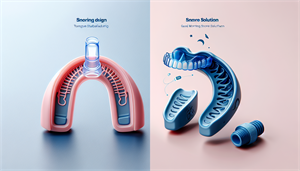
An In-Depth Guide to How Do Snoring Mouthpieces Work
Are you fed up of sleepless nights due to your partner’s snoring? Do you want a reliable solution that can enable both of you to get some sound restful sleep without interruption? If so, this blog post is for you! We will discuss everything related to "snoring mouthpieces," from their functionality and ability in decreasing nighttime noise while promoting better slumber. Read on and discover more about how they operate, different types available out there as well as our top picks – all towards helping achieve an undisturbed night’s beauty sleep again.
Understanding Snoring Mouthpieces: How They Work
Snoring mouthpieces, or anti-snoring devices, are designed to help reduce snore-related issues. An example of this type of device is the popularly used Snoring Mouth Guard, which offers benefits for people who sleep on their backs and those that suffer from airway obstructions due to excessive mouth breathing. The two primary forms of such guards are: Mandibular Advancement Devices (MADs) and Tongue Retaining Devices (TRDs). MAD’s reposition one’s jaw in order to prevent any blockage present within the airways while a TRD adjusts the tongue so as not create an obstruction when trying to breath during sleeping hours. Both MADs & TRDs function effectively by altering either the position of your tongue or lower jaw thus making it easier when you inhale through nose whilst at rest - reducing episodes related to both snored loudly/ heavily.
Mandibular Advancement Devices (MADs)
Mandibular Advancement Devices (MADs) are a type of snoring mouthpiece, otherwise referred to as mandibular repositioning devices (MRDs). Examples of MADs include: SnoreRx, ZQuiet and SleepTight Mouthpiece. They work by pushing the lower jaw forward and keeping the airway open, which prevents the tongue from slipping back—a frequent source of snore-inducing blockages. Though MADs can be useful in treating persistent snoring issues, some people may suffer side effects such as tenderness or rigidity in their jaws after using them. Drooling or discomfort due to dental implants/braces/dentures might also occur. The device costs approximately $75-$150 per unit, but requires a prescription prior to purchase in most cases.
Tongue Retaining Devices (TRDs)
Tongue Retaining Devices (TRDs) are designed to hold the tongue and jaw in a forward position so as to keep an open airway while sleeping. The Good Morning Snore Solution, being one of these popular devices, is suitable for those with dentures, braces or dental implants who cannot use MADs due to temporomandibular joint dysfunction (TMJ) or other types of jaw pain related issues. These TRDs usually cost around $100 making it affordable for most people. The Good Morning Snore Solution works by keeping the tongue at a steady forward angle which prevents it from sliding back into the throat blocking airflow. Therefore, reducing snoring noises during sleep – this device also comes with 30-night trial period allowing users to try out its efficiency before deciding if they should buy it permanently!
Types of Anti-Snoring Mouthpieces: Custom vs. Over-the-Counter
When it comes to choosing the right snoring mouthpiece, there are two main options: Custom-made and Over-the-counter (OTC). Each has its own merits as far as effectiveness, comfortability and expense go. Knowing these distinctions can help you decide which type is most suitable for your requirements. Custom made devices constructed in specialised dental labs may provide a better fit than off-the-shelf of


